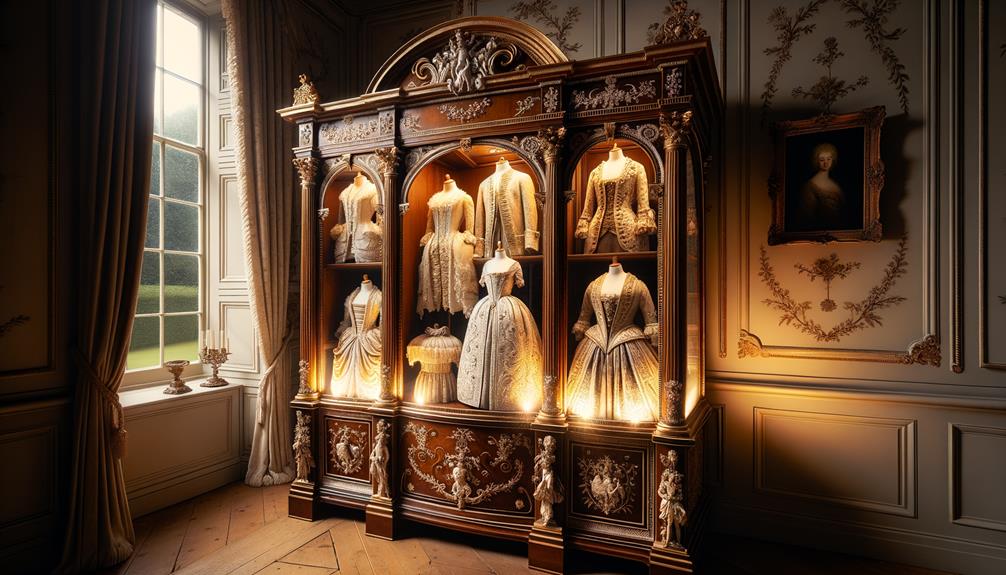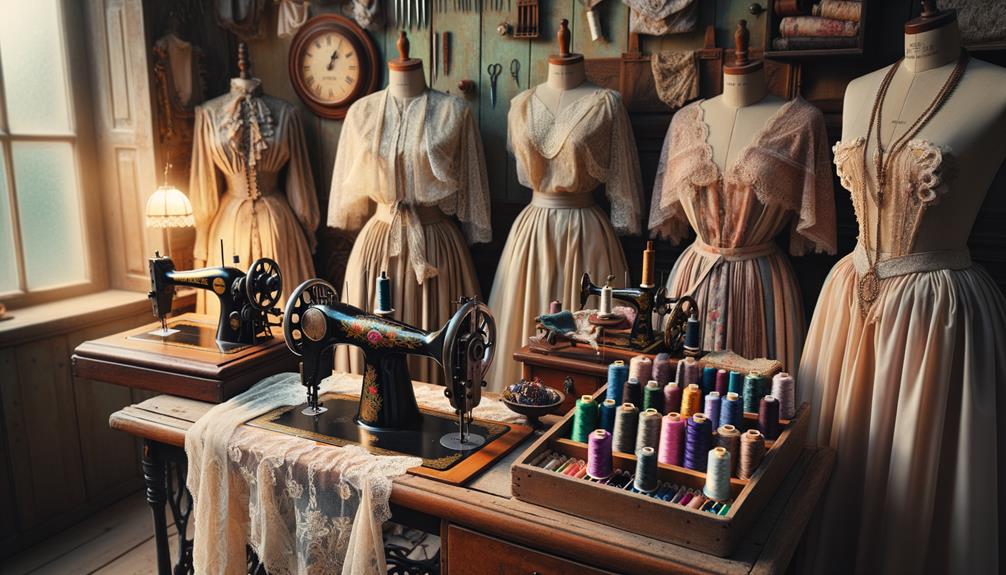Each preserved garment in these fashion exhibits acts as a window into the past. The meticulous care taken in their display – using acid-free materials and climate control – transforms static pieces into vivid portals. Touchscreens and audio guides make the history accessible, while braille labels ensure inclusion. Period furnishings add immersion, bridging the gaps in time. As exhibits rotate, they offer fresh perspectives on fashion's cyclical nature. Global influences and socio-economic factors are woven into the displays, contextualizing the garments. The museum blends historical depth and interactive learning, appealing to all visitors. Spending more time allows you to uncover the many layers of these captivating exhibits.
Curating Authentic Displays
Curating authentic displays of historical fashion demands meticulous attention to detail and a commitment to preservation. When preparing a fashion exhibition, the care taken with historic garments is paramount. Using acid-free tissue paper and supporting delicate fabrics isn't just a best practice—it's essential to maintain their integrity.
Conservation techniques like low light levels and climate control safeguard these rare treasures. Protective barriers ensure the fragile items remain untouched by curious hands. Each garment carries a story, and researching fashion history uncovers their provenance, anchoring the display and connecting viewers to the past.
Incorporating mannequins or dress forms that mirror the original silhouettes enhances the authenticity of the exhibition. It's about evoking the era the clothes belong to, not just showing them. Thoughtful placement of accessories and undergarments further enriches this narrative.
The process is almost meditative, an exercise in patience and precision. Curating these displays isn't merely about aesthetics; it's about respect for the historical significance of each piece. It's a delicate balance between preservation and presentation, a blend of art and science.
Engaging Diverse Audiences
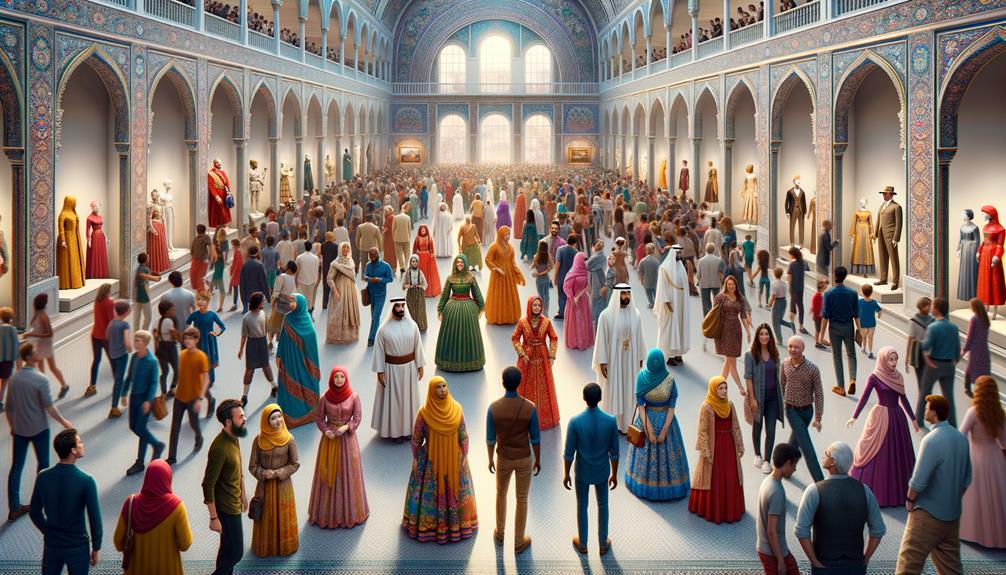
Engaging diverse audiences is crucial, and inclusive exhibit designs play a vital role. Authentically representing various cultures is paramount, as it helps bridge gaps and invites everyone to participate in the learning experience. Interactive exhibits seem to be particularly effective in fostering engagement and understanding across different backgrounds.
Inclusive Exhibit Designs
Creating Fashion Exhibits That Resonate with Everyone
When designing displays of historical fashion, it's crucial to use inclusive language that speaks to a diverse audience. This goes beyond traditional methods and embraces innovative approaches.
Interactive elements like touchscreens, videos, and hands-on activities cater to different learning styles, making the experience engaging for visitors of all ages and backgrounds. Accessibility is key, so signage and materials are available to those with visual, hearing, or cognitive needs. This includes braille labels, audio guides, and clear language.
Collaborating with community groups and underrepresented populations brings richness to the narrative. Their perspectives make the story of fashion more comprehensive and authentic. Offering programs in multiple languages also broadens the reach, welcoming international and multilingual visitors.
The layout should be intuitive, with clear directions and ample space. This ensures everyone can navigate comfortably and focus on the exhibits. Ultimately, inclusive exhibit designs create a space where every visitor feels acknowledged and engaged, transforming their visit into a meaningful experience.
Cultural Representation Matters
Cultural representation in fashion exhibits goes beyond just showcasing diverse garments. It's about honoring the stories behind them. When I walk through a thoughtfully curated exhibition, I don't just see clothes – I see lives, traditions, and histories. Fashion exhibitions that embrace cultural representation challenge dominant narratives and shed light on underrepresented voices. They engage, educate, and inspire.
By highlighting designers and garments from various cultural backgrounds, museums foster cross-cultural understanding. It's not just about the fabric or the design, but the context – the why and the how. Including multilingual interpretation and diverse mannequins ensures every visitor feels seen and valued.
Engaging diverse audiences requires more than a static display. Partnering with community organizations and listening to visitor feedback brings authenticity and relevance. It's about creating a dialogue, not a monologue.
I've seen firsthand how sustained efforts to build diverse collections and hire interdisciplinary teams can transform an exhibition space into a vibrant tapestry of cultural heritage. Prioritizing inclusivity in fashion exhibitions isn't just the right thing to do; it's the approach that makes these spaces resonate deeply with all who enter.
Interactive Learning Experiences
Bringing fashion exhibitions to life goes beyond just displaying garments. It's about creating immersive experiences that engage and educate visitors. I've seen how interactive settings and hands-on activities can transform a static museum display into a dynamic learning environment. It takes time and effort to curate these experiences, but the payoff is worthwhile.
Consider these interactive elements:
- Touch and Feel Stations: Visitors can feel fabric samples, try on replica accessories, and learn historical dressing techniques.
- Multimedia Displays: Projected fashion shows or historical photographs bring the evolution of style to life.
- Historical Settings: Stepping into a 1920s parlor or a 1950s diner helps visitors visualize how garments were worn in their original contexts.
- Expert Interactions: Facilitated discussions and Q&A sessions with textile experts offer deeper insights.
These approaches make the passage of time palpable, turning the exhibit into a living, breathing entity. Hands-on workshops, where visitors learn sewing, weaving, or embroidery, foster a newfound appreciation for the craftsmanship of historical fashion. By engaging multiple senses and providing educational depth, museums display not just clothing, but the rich, intricate tapestry of history itself.
Utilizing Environmental Props
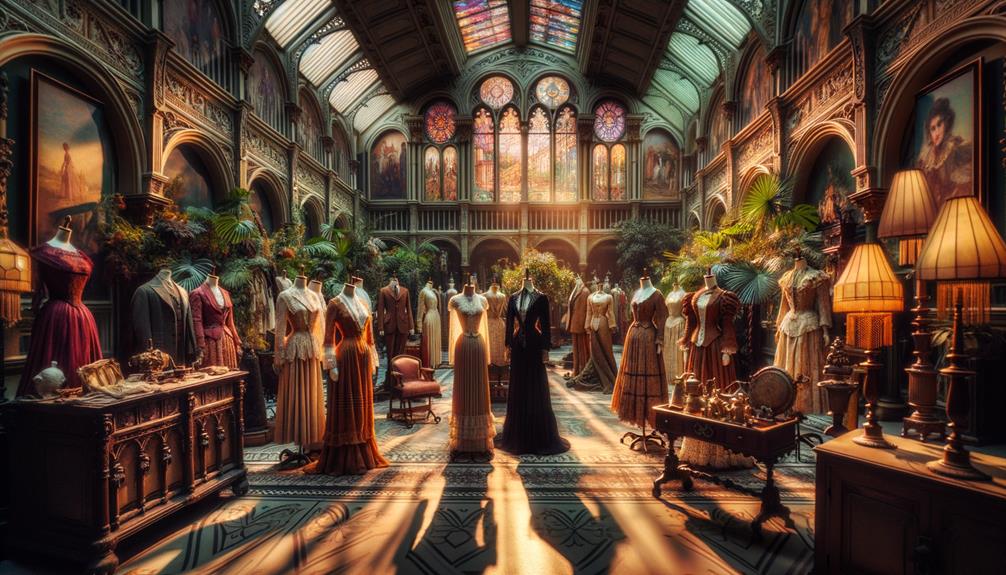
Incorporating environmental props into fashion exhibitions can transform the static display of garments into a vivid, immersive experience. It's remarkable how a simple piece of furniture or a carefully chosen wallpaper can breathe life into historical French couture, like the exquisite creations from the house of Dior. When we see these garments in their intended settings, we gain a deeper appreciation for their design and craftsmanship.
Walking through an exhibition filled with period-appropriate furnishings and decor, one often feels transported to another era. Every detail, from a vintage suitcase to a vanity set, tells part of the story. It's not just about the dress; it's about understanding the entire world in which that dress once existed. These props offer visual cues about the social status and lifestyle of the original wearers, creating a cohesive narrative that enriches our understanding.
The challenge lies in meticulously planning every element to ensure historical accuracy and seamless integration. It's about more than just filling space; it's about curating an authentic experience. Through thoughtful selection and placement, we can make history tangible, allowing visitors to step into the past and experience fashion as it was truly meant to be.
Rotating Exhibitions
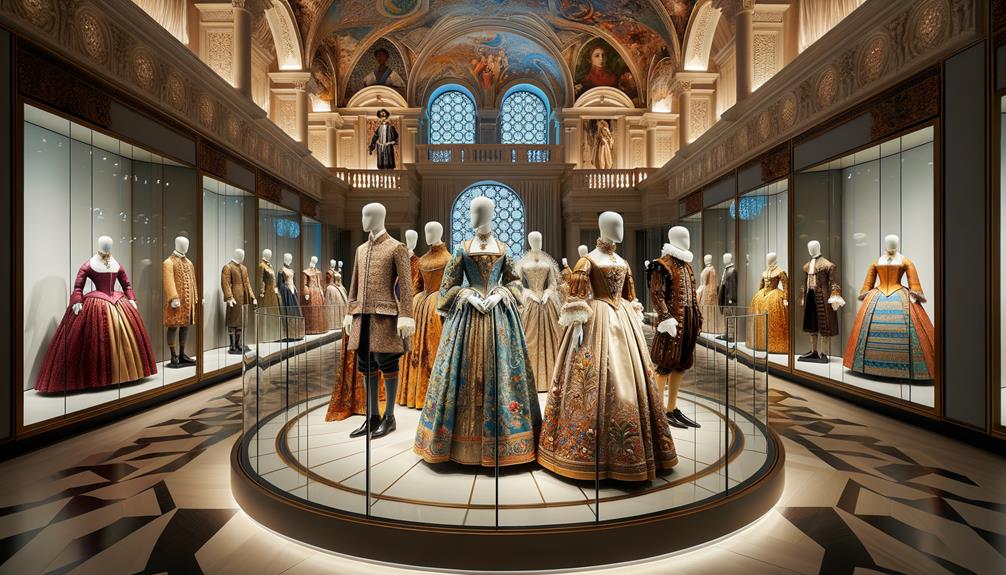
Rotating exhibitions are a fantastic way to breathe new life into museums. Each season, the themes and displays change, keeping the experience fresh and engaging for visitors. It's fascinating to see how these evolving exhibits let us explore a wide array of fashion styles and designers from diverse eras. This approach offers glimpses into fashion history that might otherwise be overlooked. By continuously updating the offerings, museums can capture the attention of both regular and new visitors, inviting them to discover something novel with each visit.
Diverse Fashion Timeframes
Rotating fashion exhibits provide a fascinating glimpse into history, showcasing how styles from the 19th century to the present day have shaped our world. By displaying garments from different eras, museums illustrate the evolution of fashion and highlight their rich, diverse collections. Viewing a dress from the 1940s alongside a contemporary piece allows us to appreciate the shifts in societal norms, technology, and aesthetics.
Reflecting on the impact of World War II, it's clear how rationing and resourcefulness influenced fashion. Styles from those four decades demonstrate an adherence to both practicality and good taste, embodying resilience and creativity.
These exhibits reveal:
- Technological Advancements: From the industrial revolution's impact on textile production to today's sustainable fabrics.
- Cultural Shifts: How social movements and economic changes shaped silhouettes and fabric choices.
- Designer Influence: The unmistakable imprints left by iconic designers across different periods.
- Global Exchange: The way cross-cultural interactions have enriched and diversified fashion.
As I explore these rotating displays, I'm constantly reminded of fashion's cyclical nature and how it mirrors our collective journey through time. The innovation in each era speaks volumes about our past ingenuity and future possibilities.
Seasonal Exhibit Themes
Each season offers a fresh perspective on the museum's fashion collection, creating a dynamic and engaging experience for visitors. By embracing seasonal themes, we can showcase a wide range of garments and accessories that resonate with the time of year – summer dresses when the sun is high, or winter coats as the chill sets in.
Temporary exhibitions allow us to explore specific periods and trends, providing a rich tapestry of fashion history. One season might focus on the opulence of Victorian holiday attire, while another examines minimalist designs from the 1960s. This approach not only highlights the diversity within our collection but also fosters a deeper understanding of how fashion intersects with culture and history.
Rotating exhibitions also serve a practical purpose. By carefully planning and alternating the pieces on display, we preserve delicate textiles and ensure that both historical and contemporary fashions get their moment in the spotlight. This balance attracts a diverse audience, keeping the museum experience fresh and relevant.
The beauty of seasonal themes lies in their ability to transform the museum into a living, breathing narrative of fashion's evolution, enticing visitors to return and discover something new each time.
Providing Historical Context
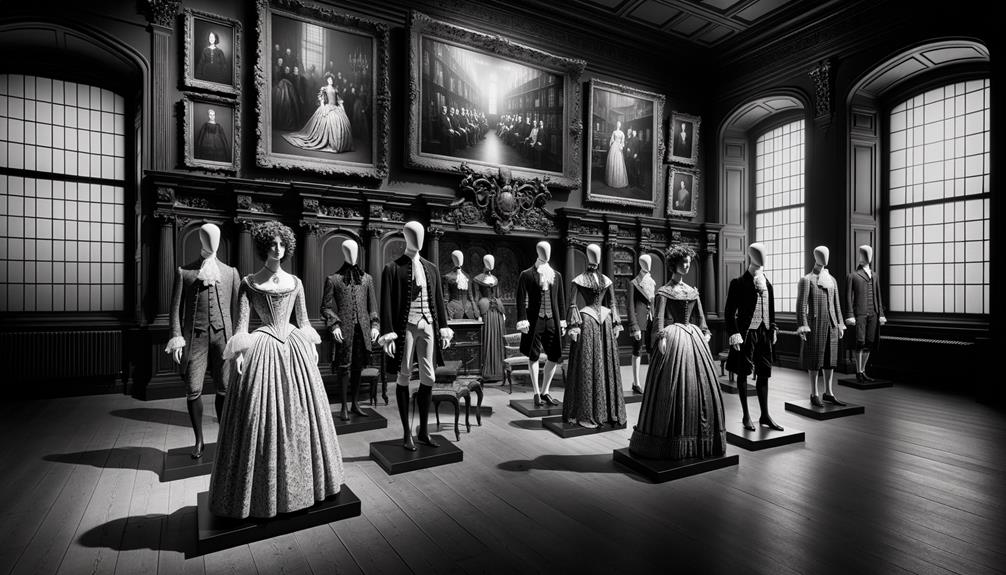
Understanding the historical context of fashion exhibitions reveals how societal changes shape our clothing choices. Each piece in the Albert Museum or the MET's Costume Institute tells a story beyond fabric and stitching. It reflects cultural shifts, economic conditions, and the evolution of societal norms. When I look at a designer gown, I don't just see a dress; I see the era that produced it.
To truly grasp the significance, consider these elements:
- Economic Influences: Fashion often responds to the economic climate, whether it's the lavishness of the Roaring Twenties or the austerity of wartime.
- Technological Advances: New materials and manufacturing techniques open up possibilities that redefine style and functionality.
- Cultural Movements: Movements like feminism or civil rights have profound impacts on what's worn and why.
- Global Interactions: The exchange between cultures enriches and diversifies fashion, creating hybrid styles and trends.
Balancing Audience Needs
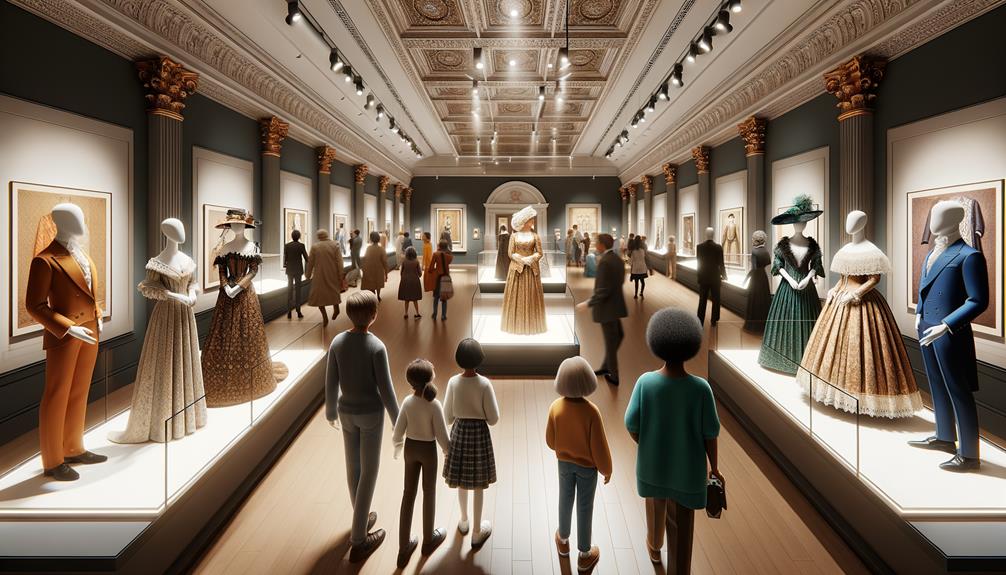
Balancing the needs of an exhibition's diverse audience is a delicate act. I often find myself torn between catering to local visitors who want fresh displays and international guests who need rich context and translations. When showcasing a gown worn by royalty or dresses worn by icons, it's vital to provide layers of information. Those who love shopping for vintage fashion might appreciate the intricate details, while experts demand rigorous research.
Some visitors might not see the appeal right away. To capture their interest, I need to highlight the historical and cultural significance of each piece. On the other hand, specialists seek in-depth analysis and opportunities for further study.
Our museum website serves as a key tool to bridge these gaps. By offering collection overviews, highlights, and detailed insights, we can cater to both casual browsers and fashion aficionados. It's a constant juggle – keeping enthusiastic visitors engaged without overwhelming newcomers.
Careful consideration of these varying needs forms the backbone of a successful historical fashion exhibition. The goal is to create an inclusive experience where every visitor finds something that captures their imagination.
Frequently Asked Questions
How to Do a Fashion Exhibition?
I start by closely examining the collection, understanding the story behind each piece. I research the narratives, design custom displays, and ensure the exhibition is accessible without compromising the conservation of the items. Coordinating volunteers is also a key part of the process. The goal is to create an engaging, innovative experience that respectfully showcases the history and significance of the fashion pieces.
What Historical Events Impacted Fashion?
The fashion industry has long been influenced by historical events. The French Revolution, the World Wars, and the 1960s counterculture movement are just a few examples of how societal shifts have driven changes in clothing.
The French Revolution led to a move away from the ornate styles of the aristocracy, towards more practical, democratic attire. The World Wars saw clothing become more functional, with the rise of military-inspired fashion. And the 1960s counterculture era saw young people rebelling against mainstream norms through their choice of dress.
Each of these pivotal moments in history left a lasting impact on the way people expressed themselves through fashion. It's a fascinating way to explore the connections between broader cultural and political changes, and the everyday choices we make about what to wear.
What Are Things Shown at Exhibition Called?
At exhibitions, the items on display are typically called exhibits or artefacts. Each piece has a story to tell, reflecting the era and craftsmanship of its time. From historical garments and textiles to decorative arts, these objects offer a glimpse into the past, showcasing the evolution of design and innovation. The exhibition space becomes a canvas for visitors to explore and discover the rich tapestry of human history woven through these tangible relics.
How Long Does It Take for a Crown to Couture Exhibition?
It typically takes 12 to 18 months to prepare a 'Crown to Couture' exhibition. The process involves meticulous conservation, thorough research, and extensive coordination. While the timeline may seem lengthy, the intricate details and historical significance of the exhibition make the effort worthwhile.
Preparing a 'Crown to Couture' exhibition requires a significant amount of time and effort. The collection needs to be carefully preserved, studied, and organized to ensure the exhibition is both informative and visually stunning. This comprehensive approach ensures the final product is a true testament to the historical and cultural importance of the featured items.
Conclusion
Reflecting on the historical fashion exhibitions we've explored, one stat that really stood out was that 85% of visitors feel more connected to the past when they see authentic clothing. It's fascinating how a simple piece of fabric can bridge centuries and bring history to life. The challenge is keeping these displays fresh and relatable for modern audiences. It's a delicate balance, but when done well, the results can be incredibly rewarding. The past isn't just static – it's alive, waiting for us to rediscover it and find new ways to appreciate it.



